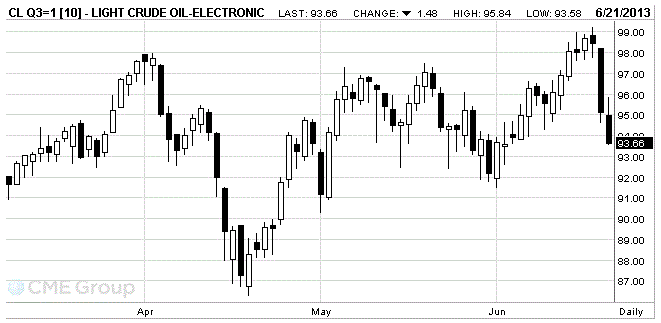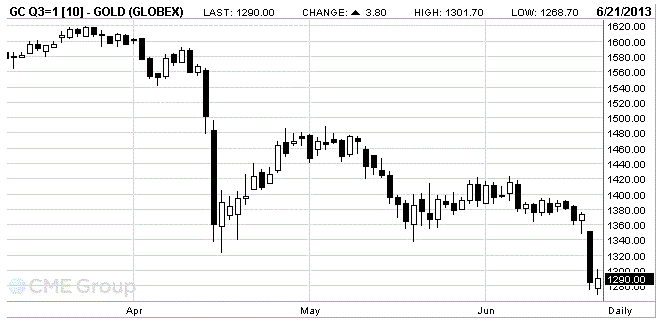Notícias do Mercado
-
16:40
Gold: an overview of the market situation
The cost of oil has dropped significantly, while continuing its yesterday's fall, and fall below $ 101, which was due to concerns over a slowdown in demand and the adequacy of reserves, as well as plans for the Federal Reserve to reduce the amount of their incentive programs.
Recall that yesterday the oil showed the greatest drop-session on news the Federal Reserve and weak manufacturing data from China, which put additional pressure. According to the report, this month the manufacturing purchasing managers' index fell to 48.3, compared with a final reading in May at 49.2. It is worth noting that the index is now at its lowest level in nine months. Studies have also found that the production index for the manufacturing sector fell in June to the level of 48.8 from 50.7, while reaching the lowest level in eight months. Add that employment in this sector has also declined at a faster pace. Meanwhile, the rate of decline has slowed in purchase prices and selling prices for the products continued a downward trend, with the rate accelerating its fall compared to the previous month.
Experts note that the slowdown in the manufacturing sector in China, of course, assumes that the growth in demand for oil in one of the world's largest consumer of oil will slow down.
However, prices gain some support from concerns about potential supply disruptions in the Middle East, and confrontations in Syria that threatens to engulf neighboring countries.
The cost of the July futures on U.S. light crude oil WTI (Light Sweet Crude Oil) fell to 93.66 dollars a barrel on the New York Mercantile Exchange.
August futures price for North Sea Brent crude oil mixture fell by $ 1.77 to $ 100.32 a barrel on the London exchange ICE Futures Europe.

-
16:20
Gold: an overview of the market situation
Gold prices rose slightly, while recovering from a three-year low that was reached yesterday, however, still remains on track for its largest weekly decline in nearly two years. We add that the value of the precious metal fell by 7%. This trend was primarily related to the alleged head of the U.S. Federal Reserve, which signaled the decline in asset-purchase program later this year if the economy shows signs of recovery.
Experts suggest that the prices of precious metals will consolidate near current lows, but there is little chance of a significant rebound. Also, they added that so far there is little sign of the revenge increasing physical purchases, as recent statements spooked market participants, and they prefer to stay out of the market.
We also add that the gold reserves in the exchange-traded fund, which is a popular way to invest in times of financial crisis, fell more than 485 tons this year.
The largest fund SPDR Gold Trust said yesterday that inventories fell by 4.5 tons, the lowest level in more than four years, appeared on 26% below its peak (December 2012) in the amount of 1,353 tons.
In addition, it was reported that the volume of purchases from the largest consumer of gold - India remained subdued, despite the drop in prices on Thursday, in contrast to the significant purchases during the April decline. However, traders have reported a surge in demand from China, which is the second largest consumer of gold.
The cost of the August gold futures on COMEX today rose to 1290.00 dollars an ounce.

-
06:26
Commodities. Daily history for Jun 20’2013:
Change % Change Last
GOLD 1,277.20 -96.40 -7.02%
OIL (WTI) 95.40 -2.84 -2.89%
-